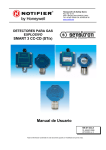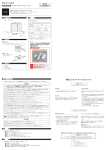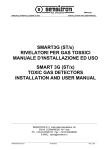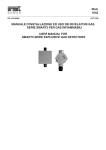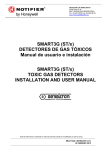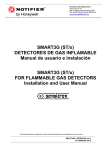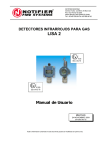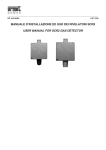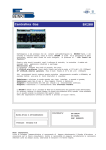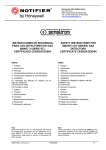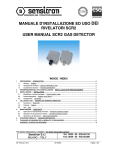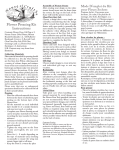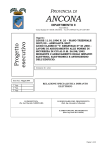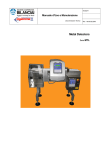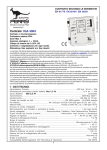Download MANUALE D`INSTALLAZIONE ED USO DEI RIVELATORI SMART 3
Transcript
MANUALE D’INSTALLAZIONE ED USO DEI RIVELATORI SMART 3 (NET/x) PER GAS INFIAMMABILI USER MANUAL FOR SMART 3 (NET/x) EXPLOSIVE GAS DETECTORS II 2G EEx d IIC T6 II 2G EEx d IIC T6 II 3GD EEx nA IIC T6 II 3GD EEx nA IIC T6 Per ulteriori informazioni, contattare/For further information: Sensitron S.r.l. Tel. 0039 - 02 - 935.48.155 Fax: 0039 - 02 - 935.48.089 e-mail: [email protected] MILANO - ITALY MT1015.doc rev. 4 14/05/2004 Pag. 1 di 14 MANUALE INSTALLAZIONE / USER MANUAL SMART 3 INDICE / INDEX 1 INTRODUZIONE / INTRODUCTION................................................................................3 1.1 1.2 1.2 1.3 1.3 Descrizione................................................................................................................................ 3 Identificazione rivelatore per gas esplosivi................................................................................ 4 Flammable gas detectors identification ..................................................................................... 4 Caratteristiche tecniche per gas esplosivi ................................................................................. 5 Explosive gas technical characteristics ..................................................................................... 5 2 PREDISPOSIZIONE DEL SITO D’INSTALLAZIONE/INSTALLATION SITE PREARRANGEMENT............................................................................................................6 3 INSTALLAZIONE / INSTALLATION................................................................................6 3.1 3.1 3.2 3.2 Modalità per il corretto montaggio................................................................................................. 6 Correct positioning mode........................................................................................................... 6 Schema topografico circuito ...................................................................................................... 7 Detector circuit layout ................................................................................................................ 7 3.3 3.3 3.4 3.4 3.5 3.5 Collegamento, modalità stand alone oppure uscita 4-20 mA ................................................... 8 Stand alone or 4-20 mA output connection ............................................................................... 8 Collegamento uscita seriale RS485 (fornita come optional) ..................................................... 9 RS485 serial output connection ................................................................................................ 9 Configurazione indirizzi per rilevatori IDI................................................................................. 10 IDI address configuration ........................................................................................................ 10 3.2.1 SCHEMA TOPOGRAFICO SCHEDA 3 RELÈ (OPZIONALE) ........................................................................................ 7 3.2.1 3-RELAY CARD LAYOUT..................................................................................................................................... 7 (OPTIONAL) ................................................................................................................................................................ 7 3.2.2 SCHEMA TOPOGRAFICO SCHEDA 1 RELÈ O 2 OPEN COLLECTOR (OPZIONALE) .................................................... 7 3.2.2 1-RELAY OR 2-OPEN COLLECTOR CARD LAYOUT (OPTIONAL) ............................................................................... 7 3.2.3 PROGRAMMAZIONE DEL RIVELATORE ................................................................................................................. 7 3.2.3 DETECTOR PROGRAMMING................................................................................................................................ 7 4 COLLAUDO E USO / TESTING AND WORKING OPERATIONS .................................11 4.1 4.1 4.2 4.2 4.3 4.3 5 Accensione .............................................................................................................................. 11 Power ON ................................................................................................................................ 11 Collaudo .................................................................................................................................. 11 Testing ..................................................................................................................................... 11 Uso .......................................................................................................................................... 11 Use .......................................................................................................................................... 11 MANUTENZIONE / MAINTENANCE .............................................................................12 5.1 5.1 5.2 5.2 5.3 5.3 6. 7 8 10 10 Manutenzione preventiva ........................................................................................................ 12 Preventive maintenance routines................................................................................................. 12 Manutenzione correttiva .......................................................................................................... 12 Corrective maintenance routines ................................................................................................ 12 Istruzioni per la dismissione .................................................................................................... 12 Disassembly instructions ......................................................................................................... 12 ISTRUZIONI PER L’IMBALLAGGIO / PACKING INSTRUCTIONS...............................12 SEGNALAZIONI DI ALLARME E DI GUASTO / ALARM AND FAULT INDICATIONS.12 ACCESSORI / ACCESSORIES .....................................................................................13 TAGLIANDO DI GARANZIA PER LA MODALITA’ DI RIPARAZIONE .........................14 WARRANTY COUPON FOR REPAIRING.....................................................................14 MT1015.doc rev. 4 14/05/2004 Pag. 2 di 14 MANUALE INSTALLAZIONE / USER MANUAL 1 INTRODUZIONE / INTRODUCTION 1.1 Descrizione SMART 3 I Rilevatori di gas della serie SMART 3 (nome commerciale del rilevatore ATEX NET/x) vengono impiegati per rilevare, in una atmosfera costituita principalmente da aria, la presenza di sostanze combustibili, in concentrazioni esprimibili in % LIE (Limite Inferiore di Esplosività). Il sensore industriale (PELLISTORE) utilizzato nelle versioni per miscele esplosive conferisce una precisione ed una selettività ottimale con la maggior parte dei gas esplosivi, evitando al massimo falsi allarmi. Il microprocessore presente sulla scheda elettronica del rivelatore, oltre al normale funzionamento è provvisto dei seguenti algoritmi software: Autodiagnosi del sistema, che verifica costantemente il corretto funzionamento dell’hardware, sensore compreso. Durante tale fase il LED rosso lampeggia molto lentamente Inseguitore di Zero per il mantenimento del parametro del sensore prescindendo da possibili derive dovute a variazioni termiche o fisiche del sensore stesso. Filtro digitale che consente di correggere fenomeni transitori che potrebbero causare una instabilità del sistema o errori di lettura con conseguenti falsi allarmi; Ciclo d’isteresi viene applicato alle uscite digitali associate alle soglie d’allarme e consente l’eliminazione delle continue commutazioni nell’intorno dei punti di soglia. Watch-dog per il controllo del microprocessore. In caso di intervento la corrente di uscita viene forzata a 0mA, il led rosso di segnalazione resta acceso. Se sul rilevatore è presente la scheda seriale RS485 la trasmissione viene interrotta; se sul rilevatore è installata la scheda 3 relè, il relè di Fault si attiva. Il Rivelatore fornisce una uscita proporzionale in corrente (4-20 mA) corrispondente a llo 0-100 % LIE (Limite Inferiore d’Esplosività). Due schede opzionali sono disponibili per offrire le seguenti prestazioni: -una scheda dotata di 3 relè (ST.S3REL) con contatti puliti liberi da tensione. Un relè è associato all' uscita di Fault e watch-dog mentre gli altri due possono essere associati a due delle tre soglie di allarme presenti. -una scheda tramite la quale il rivelatore è in grado di dialogare in seriale RS485 con centrali indirizzate Sensitron della linea IDI. Lo SMART 3 viene commercializzato: -nel contenitore antideflagrante EEx d certificato ATEX, -nel contenitore EEx nA. Nota: I certificati ATEX riportano come nome prodotto NET/x essendo quest’ultimo il nome del progetto. MT1015.doc rev. 4 14/05/2004 1.1 Description SMART 3 gas detectors (trade name of the NET/x ATEX detector) are used in atmospheres where the principal constituent is air to detect the presence of combustible substances, with concentrations expressed as a % LEL (Lower Explosion Limit). The professional industrial type catalytic sensor (PELLISTOR) employed for the detection of flammable compounds offers a great precision and selectivity with most of the explosive gases, thus avoiding false alarms. The management software incorporates algorithms designed to correct the effects of transients, which may cause unstable operation or incorrect readings with associated false alarms. The main software algorithms are: Self diagnostic procedure to control the detector main operational parts, both hardware and sensing element. During this phase the red LED blinks very slowly Zero point tracking to maintain the zero parameter of the sensor apart from possible drifts due to thermal or physical variations of the sensor. Digital filter employed in the digital analysis of the analogue values sampled, it allows correcting phenomena that might cause system' s instability or wrong readouts thus provoking false alarms. Hysteresis cycle applied to the outputs to eliminate continuous O.C. switching close to the preset alarm thresholds. Watch-dog for the microprocessor control. In case of intervention the output current drops down to 0mA. The red LED stops blinking and remains on. If the serial board RS485 is plugged in, transmission will be interrupted. If the 3-relay card is plugged in, Fault relay will activate. The detector offers a proportional output current (420mA) corresponding to 0-100% LEL (Lower Explosion Limit). Two optional cards are available to offer the following facilities: -A three-relay card (ST.S3REL) with tension free changeover contacts. One relay is associated to Fault and Watch-dog. The remaining two are to be associated to two out of the three preset thresholds. -An internal identification card to make SMART3 communicate on RS485 bus with Sensitron IDI control panels SMART 3 is available: -in Explosion proof EExd ATEX certified enclosure; -in EEx nA enclosure. Note: The ATEX certificates refer to NET/x detectors, being these our internal project codes. Pag. 3 di 14 MANUALE INSTALLAZIONE / USER MANUAL 1.2 SMART 3 Identificazione rivelatore per gas esplosivi MT1015.doc rev. 4 14/05/2004 1.2 Flammable identification gas detectors Pag. 4 di 14 MANUALE INSTALLAZIONE / USER MANUAL 1.3 SMART 3 Caratteristiche tecniche per gas esplosivi Elemento sensibile Sensing element Testa sensore Sensor head Campo di misura Risoluzione Alimentazione Assorbimento a 12Vcc Measurement range Resolution Power supply Consumption at 12Vdc Unità di controllo Segnalazioni luminose Control unit Visual indications Uscita proporzionale Proportional output Resistenza di carico massima Uscita digitale seriale (opzionale) Uscite a relè con led di indicazione stato (opzionale) Procedura di autozero Maximum load resistance Serial Output (optional) Relay outputs, with status indicating LED (optional) Auto zero routine Filtro digitale Digital filter Risoluzione (microprocessore) Display (dove previsto) Precisione Resolution (microprocessor) Display (when foreseen) Precision Tempo preriscaldamento Tempo stabilizzazione Warm-up time Stabilization time Response time Repeatability (versione senza display) Tempo di risposta Ripetibilità Temperatura di stoccaggio (version without display) Temperatura operativa Umidità relativa Pressione di esercizio Velocità dell’aria Peso Storage temperature Operating temperature Relative humidity Operative pressure Air velocity Weight Watch-dog Watch-dog (versione senza display e con testa standard) (version without display and with standard head) Dimensioni Dimension Orientamento Orientation Marcatura ATEX ATEX marking Normative di riferimento Norm references Certificati CE del tipo (come NET/x) EC Type Certificates (as NET/x) 1.3 Explosive gas characteristics PELLISTORE NEMOTO serie NET PEL (NET PEL NEMOTO PELLISTOR) Certificata ATEX CESI 01ATEX013U o CESI 01ATEX066U (ATEX certificate ATEX CESI 01ATEX013U or CESI 01ATEX066U) 0 -100% LIE; 0 – 100 % LEL Out analog 0,025 mA; Display +/-1%, +/- 1 digit 12- 24 Vdc - 20% + 15% 90 mA ( medio / medium ); 130 mA (massimo/max) Microprocessor 10 bit Led ad intermittenza Flickering LED 4-20 mA (default) o 0-10-20mA (versione twin) 4-20 mA (default) o 0-10-20mA (twin version) 200Ω RS-485 per centrale GALILEO IDI; RS 485 for GALILEO IDI gas control panel N° 3 relè contatti in scambio liberi da tensione 24V-1A 3 relays with tension free changeover contacts 24V-1A Compensazione delle derive di zero / Zero drift compensation medie mobili sui valori acquisiti / variable average on the values sampled 1024 punti / points A 4 digit luminosi; 4 luminous digits ±5% F.S. oppure 10% della lettura ±5% full scale or 10% readout 5 minuti; 5 minutes < 2 minuti; < 2 minutes < 20 sec. T50; < 60 sec. T90 ± 5% del F.S. oppure 10% della lettura ±5% Full scale or 10% readout -25 / + 60 °C -10 / + 60 °C 20-90 % Rh / 40° C 80-110 KPa < 6 mS EEx d 900 gr. EEx nA 800 gr. Interno per il controllo del microprocessore Internal, for the microprocessor status control EExd: L.105, H. 200, D. 110 mm EExn: L.106, H.180, D.62 mm. Installazione verticale con sensore rivolto verso il basso / The detector must be mounted sensor head downward 722 II 2G EEx d IIC T6 722 II 3GD EEx nA IIC T6 EN50014 EN 50018 EN 50021 (Requisiti essenziali di sicurezza, EEx-d ed EEx-n) (Electrical Safety Requirements, EEx-d and EEx-n) EN 61779-1/4 (Prestazioni / Performances) CESI 01ATEX053 CESI 03ATEX339 CESI 02ATEX084 flammable gas version) MT1015.doc rev. 4 technical 14/05/2004 (Requisiti essenziali di sicurezza, versione EEx-d) (Electrical Safety Requirements, EEx-d version) (Requisiti essenziali di sicurezza, versione EEx-n) (Electrical Safety Requirements, EEx-n version) (Prestazioni; ver. gas infiammabili / Performances; Pag. 5 di 14 MANUALE INSTALLAZIONE / USER MANUAL 2 SMART 3 PREDISPOSIZIONE DEL SITO D’INSTALLAZIONE/INSTALLATION SITE PREARRANGEMENT Durante le operazioni di montaggio/installazione, gli impianti devono essere messi in sicurezza. Ricordiamo anche come in fase di installazione sia opportuno tenere in considerazione alcune norme generali in quanto un posizionamento non corretto può pregiudicare il funzionamento ottimale del rivelatore. Si raccomanda di non installare rivelatori gas nelle vicinanze di prese d’aria e/o ventilatori che provocano forti correnti d’aria. I rivelatori non devono essere altresì posti in zone nelle quali siano presenti vibrazioni e, sebbene immuni da disturbi a radiofrequenze è consigliabile non installarle in prossimità di emettitori radio (ponti radio o apparecchiature simili). Altra buona norma è quella di installare il rivelatore in zone facilmente accessibili per le operazioni di test e calibrazione e per l’inserimento dell’adattatore del kit di calibrazione. Tutti i gas più leggeri dell’aria, disperdendosi nell’ambiente occuperanno la parte alta dell' ambiente ed il rivelatore deve quindi essere posizionato a 30 cm dal soffitto per ottenere un efficace intervento. I gas più pesanti dell’aria,GPL, Butano, Vapori benzina al contrario, disperdendosi stazioneranno nella parte bassa dell’ambiente ed il rivelatore deve quindi essere posizionato a 30 cm dal pavimento. At the mounting/installation phase be sure all safety precautions have been considered. Always consider how important it is the correct positioning of gas detectors to get the optimum response. Be careful never to install gas detectors close to air intakes or fans causing strong air currents. Be sure the detectors are attached to a firm base to prevent vibration that can damage them, producing unreliable results. Although the electronics comply with the electromagnetic compatibility rules, it is advised to keep the detectors at a distance from any radio frequency senders (such as radio links or similar). Please be also sure that detectors are placed in a convenient location for future maintenance and calibration requirements. Vi sono alcune sostanze che se presenti nella atmosfera da analizzare possono alterare considerevolmente la risposta del sensore fino a danneggiarlo irrimediabilmente(es. siliconi, silicati alogeni, tetraetile di piombo, acido solfidrico, tetracloruro di carbonio tricloroetilene-trielina ). Allorché si presuma la presenza di queste sostanze, si consiglia di verificare frequentemente e sempre dopo ogni intervento degli allarmi, la sensibilità del rilevatore con gas di taratura. There are some substances that, when present in the atmosphere being analysed, can considerably change the response of the sensor and even damage it irremediably, in particular silicones, silicon halides, tetraethyl lead, hydrogen sulphide, carbon tetrachloride, trichlorethylene Whenever their presence is presumed, it is recommended to check the detector' s sensitivity at short time intervals, and always after an alarm intervention, with sample gas bottles. Il rilevatore viene calibrato in fabbrica specificamente per la sostanza richiesta dal cliente. Non è possibile successivamente modificare la taratura dello stesso, se non da parte del costruttore, in quanto trattasi di una procedura che richiede procedure ed attrezzature particolari. Detectors are factory calibrated for the specific gas required by the customers. Future modification of the preset calibration can be carried out in our Laboratory only, it being a procedure requiring specific procedures and equipments. 3 INSTALLAZIONE / INSTALLATION 3.1 Modalità per il corretto montaggio + 3.1 Il rivelatore deve sempre essere installato con l’elemento sensibile (testa di rivelazione) rivolta verso il basso. Il contenitore del rivelatore, per nessuna ragione deve essere forato; per il fissaggio utilizzare i fori già esistenti. Per la versione EEx d da installare in aree classificate esplosive si raccomanda l’utilizzo di pressacavi antideflagranti per sigillare l’entrata dei cavi; per il fissaggio a muro dei rivelatori è necessario frapporre tra il rilevatore ed il muro stesso l’apposita staffa di fissaggio fornita come optional in modo da permettere l’ aggancio del KIT di calibrazione alla testa rilevatrice qualora si volesse procedere a controlli. MT1015.doc rev. 4 All of the gas lighter than air tend to spread upwards so the detector should be placed at 30 cm from the ceiling in order to maximise the effectiveness of the detection. LPG as well as Butane, Gasoline vapours and all of the gases heavier than air tend to spread downwards so the detector should be placed at 30 cm from the floor. 14/05/2004 Correct positioning mode The detector is always to be mounted with the sensing element placed downward. For no reasons at all the enclosure can be drilled. Wall mount the detectors by employing the existing holes. For EEx d versions to be mounted in classified hazardous areas we advise to use explosion proof cable glands to seal the cables inlets. To wall fix the detectors we recommend to use the brackets we supply as optional. These brackets thickness allows the right distance spacer to correctly tight the calibration kit once periodical operational testing are to be performed. Pag. 6 di 14 MANUALE INSTALLAZIONE / USER MANUAL 3.2 SMART 3 3.2 Schema topografico circuito Circuito rivelatore Smart 3 Detector circuit layout Smart 3 detector circuit Morsettiera di collegamento estraibile (Main plugin terminal board for connections) Connettore per (Plug in terminal for): - Scheda Rs485 o (RS485 board or) - Scheda a un rele o due open collector o (One relay or two open collector board or) - Scheda IRDA (IRDAboard) 1 2 3 DIP-SWITCH per selezionare le soglie (Thresholds setting point DIP-SWITCH) 1 2 3 4-20mA Uscita negativa “DEFAULT” (4-20 mA Negative output mode, default) 4-20mA Uscita positiva (4-20 mAPositive output mode) Scheda amplificatore analogica (Analog amplifier board) J11 Connettore per scheda display o relè (J11 Plug in connettor for display or relay board) Connessione elemento sensibile (Sensing element connection) Connettore di misura per controllo parte analogica (measureconnettor for checking of analog circuit part) Led di indicazione di stato (Status led indication) Scheda display opzionale Display optional board Fault led Led Alarm 1 Led Alarm 2 Led Alarm 3 Led di acceso (power on led) Display per indicazione della concentrazione di gas (Display for a gas concentration readout) Collegare a J11 (vedi sopra) (Connect to J11, see above) Porta seriale IRDA (IRDA serial port) 3.2.1 Schema topografico scheda 3 relè (opzionale) 3.2.1 3-relay card layout (optional) Consultare il manuale fornito con la stessa Please refer to the technical instruction supplied along with the card. 3.2.2 Schema topografico scheda 1 relè o 2 open collector (opzionale) 3.2.2 1-relay or 2-open collector card layout (optional) Consultare il manuale fornito con la stessa Please refer to the technical instruction supplied along with the card 3.2.3 Programmazione del rivelatore 3.2.3 Detector programming. Il rilevatore viene calibrato per il gas specificato al momento dell’ acquisto. Successivamente è possibile ricalibrare lo strumento utilizzando l’apposito strumento come specificato al punto 9. Il rilevatore viene configurato per avere di default una uscita proporzionale 4-20mA. E’ possibile ottenere uscite a 0-10-20mA corrispondenti a: -0mA: condizione di normale funzionamento o guasto -10mA: superamento prima soglia di allarme -20mA: superamento seconda soglia di allarme Configurando diversamente i dip-switch presenti sulla scheda base si possono modificare le soglie di allarme. Anche disponendo della scheda opzionale a 3 relè è possibile modificare le soglie di intervento dei relè come indicato nella tabella seguente. Detectors are factory calibrated for the specific gas required by the customers. Future modification of the preset calibration can be carried out by employing the instrument described on paragraph 9. The default configuration provides a 4-20mA proportional output. It is also possible to have outputs set at 0-10-20mA corresponding to: -0mA: correct working condition or Fault -10mA 1st alarm threshold attainment -20mA 2nd alarm threshold attainment. By modifying the dipswitches configuration on the motherboard, different alarm thresholds might be obtained. It is also possible to modify the relay intervention when using the 3-relay card, as per the following table: MT1015.doc rev. 4 14/05/2004 Pag. 7 di 14 3.3 Collegamento, modalità stand alone oppure uscita 4-20 mA 3.3 Verificare che nella confezione ci siano tutte le parti componenti.Per il collegamento del sensore con l' unità di elaborazione e alimentazione si raccomanda l' uso di cavo schermato. La sezione del cavo da utilizzare dipende dalla distanza del rilevatore dalla centrale: -per distanze inferiori a 100mt. si usino cavi con 2 sezione di 0.75 mm ; -per distanze comprese fra 100 e 200 mt si usino cavi 2 con sezione di 1.0 mm ; -per distanze comprese fra 200 e 300mt si usino cavi 2 con sezione di 1.5 mm . Nel caso vi siano giunzioni nel cavo di collegamento, assicurarsi che vi sia continuità anche sulla schermatura dei cavi. Ricordasi che la schermatura deve essere collegata a terra unicamente dal lato unità di controllo o gruppo di alimentazione, mentre non dovrà mai essere collegata sui rilevatori. Assicurarsi che la realizzazione di giunzioni sui cavi di alimentazione mediante dispositivi di serraggio o a crimpare, sia eseguito a regola d’arte con capicorda e/o morsetti che nel tempo non si ossidino o allentino. E’ sempre preferibile eseguire giunzioni saldate. Il rilevatore SMART 3 può essere collegato a centrali di sicurezza di qualsiasi tipo. Le prestazioni migliori si ottengono con una centrale di tipo analogico 4-20 mA (o con un PLC) con indicazione proporzionale della concentrazione di gas in ambiente. MT1015.doc rev. 4 14/05/2004 Stand alone or 4-20 mA output connection Please check the carton box comprises all of the components. Wiring between the detector and the control panel should be carried out with shielded cables. Wires'cross section depends on the distance between the control panel and the detector: -for a distance up to m 100 we advice a 3 core wire 2 with cross section area of 0.75 mm ; -for a distance between m 100 and 200 we recommend 2 3x1.0 mm ; -for a distance between m 200 and 300 we recommend 2 3 x 1.5 mm . Should any junctions be necessary on the wires, please make sure there is no interruption on the shield. Please remember that the shield is to be connected to the ground from the control panel side only. Also remember never to connect the shield to the connectors Ensure the wire connections, either clutching or crimping type, are duly carried out with terminals that do not oxidise or loosen. Better of all would be to solder them. The SMART 3 gas detectors are designed to be connected to any control unit accepting a 4-20 mA input signal, better when panels have an LC display for the proportional readout of the concentration. Pag. 8 di 14 MANUALE INSTALLAZIONE / USER MANUAL SMART 3 SCHEMA COLLEGAMENTO per 4-20 mA 4-20 mA CONNECTION DIAGRAM Nello schema seguente viene riportato il tipico collegamento di un rilevatore Smart 3 ad una centrale SENSITRON PL4, PLG8, MULTISCAN ecc. N.B. Nel caso di centrali con ingresso 4-20 mA è possibile collegare 1 solo rilevatore a ciascun ingresso. The following drawing shows the connection of a Smart 3 detector to a SENSITRON control panels PL4, PLG8, MULTISCAN, etc. N.B.: Control panels accepting a 4-20mA input signals allow the connection of only one detector per input. Giunto opzionale a richiesta) (optionale gland, on request) 3.4 Collegamento uscita seriale RS485 (fornita come optional) Per il collegamento della versione IDI di Smart 3 sono necessari 4 conduttori, 2 di alimentazione e due per la linea seriale RS485. Per collegare la RS485 di Smart 3 IDI ad una centrale SENSITRON IDI (indirizzata), utilizzare un cavo a 2 poli twistato e schermato (lo schermo del cavo deve essere collegato solo alla massa-terra della centrale) con la seguente sezione: Per impianti con linee seriali RS485 fino a 200m 2 utilizzare cavo sezione 0.5 mm Per impianti con linee seriali RS485 fino a 500m utilizzare cavo sezione 0.75 mm2 Per impianti con linee seriali RS485 fino a 1000m 2 utilizzare cavo sezione 1.5 mm MT1015.doc rev. 4 14/05/2004 3.4 RS485 serial output connection SMART 3 gas detectors IDI version have a RS485 serial output and are to be connected to Sensitron' s “IDI” control panels. The connection of Smart 3 IDI version should be performed with a 4-wire cable, 1 pair for the RS485 bus and 1 for the power supply. The pair for the RS485 serial line must be a 2wire, twisted and shielded (the shield must be connected with the ground only at the control unit side). Depending on the distance, the required cable sections are: For installations with serial RS485 lines up to 200m. use cable with section of 0.5 mm2 For installations with serial RS485 lines up to 2 500m. use cable with section of 0.75 mm For installations with serial RS485 lines up to 1000m. use cable with section of 1.5 mm2 Pag. 9 di 14 Il collegamento dei rivelatori sulla linea RS485 deve essere solo in configurazione a “cascata” (daisy-chain mode). Per ogni linea seriale RS485 nell' ultimo rilevatore deve essere connessa una resistenza da 120 ohm (1/4 di watt al 5%) collegata tra i terminali A e B della linea di segnale. Per la connessione invece dell’alimentazione ai rilevatori, utilizzare un cavo di sezione adeguata, in base alla distanza ed al numero di rivelatori della linea. Ad installazione eseguita controllare che su tutti i rilevatori installati ci sia una tensione minima di 12 Vdc. In questa configurazione i dip-switch presenti sulla scheda base dello SMART 3 servono per stabilire l’ indirizzo del rilevatore. Le soglie di allarme si imposteranno automaticamente alla configurazione di default; per esigenze particolari contattare il fornitore. Utilizzando la RS485 l’uscita proporzionale 420mA rimane attiva. On the RS485 line, the gas detectors must be connected only in cascade configuration (daisychain mode). For every RS485 serial line the last detector must be terminated with a 120 ohm resistor (1/4 watt at 5%) placed between terminals A and B of the signal line. For the detectors’ power supply connection use a 2-wire cable) with suitable section as function of the distance and number of detectors. Once the installation has been completed and the system is powered-on, check that each detector reaches at least 12 Vdc. In IDI mode, dip-switches on SMART3 motherboard are employed to set the detector address. Alarm thresholds will automatically set on t e default configuration. For particular needs please contact the supplier. By employing the RS485 connection, the proportional 4-20mA output will remain activated.. Esempio di collegamento rivelatori Smart 3 in versione IDI ad una centrale IDI (Smart 3 detectors IDI version connection to an IDI control unit) ALIMENTATORE (POWER SUPPLY) 12 / 24 Vdc Per il numero massimo di rivelatori collegabili alla linea Rs485 e per l’indirizzamento dei rivelatori consultare il manuale tecnico della centrale 3.5 Configurazione rilevatori IDI indirizzi per Consultare il manuale fornito con la scheda seriale MT1015.doc rev. 4 14/05/2004 For the maximun number of detectors connected to each Rs485 line and for the addressing, check the instruction manual of the control unit 3.5 IDI address configuration Please refer to the technical instruction along with the serial board Pag. 10 di 14 MANUALE INSTALLAZIONE / USER MANUAL SMART 3 4 COLLAUDO E USO / TESTING AND WORKING OPERATIONS 4.1 Accensione 4.2 Collaudo 4.3 Uso Al momento in cui il circuito viene alimentato, si accende, ad intermittenza lenta, il led rosso sulla scheda base. L’uscita in corrente è 1,5mA circa. Trascorsi 2 minuti circa il led rosso lampeggia con una frequenza pari allo stato in cui si trova il rilevatore (vedere Tabella al punto 4.3) e l’ uscita in corrente si porta a 4,0mA. Se il rivelatore è provvisto di scheda display consultare il manuale aggiuntivo fornito con gli SMART3D. Terminata la fase di preriscaldamento il rilevatore è in grado di funzionare correttamente. Sono comunque necessarie 2 ore circa affinché il rilevatore raggiunga le prestazioni ottimali. Verificare la risposta del rivelatore utilizzando una miscela a composizione nota gas/aria, e l' apposito KIT di taratura. Vedi figura al punto 8 Il rivelatore funziona automaticamente e autonomamente pertanto non è richiesto alcun contributo da parte del suo utilizzatore. In caso di malfunzionamento il rilevatore forza l’ uscita a 1.8mA circa. Se la concentrazione di gas misurata supera il 100 % LIE, il LED sul circuito stampato si accende come per la segnalazione del fault, mentre nello SMART3 Display vengono attivate tutte le segnalazioni leds; l’uscita viene forzata a 23 mA e per ripristinare il corretto funzionamento del rivelatore si dovrà togliere e ridare alimentazione. Il LED rosso lampeggiante posto sulla scheda base del circuito indica lo stato in cui il rilevatore si trova come illustrato nella tabella sottostante. Frequenza lampeggio in secondi (Flash rate seconds) 1 ON - 1 OFF 1 ON - 1 OFF 0,1 ON - 1 OFF 2 x 0,1 ON - 1 OFF 3 x 0,1 ON - 1 OFF ON ON MT1015.doc rev. 4 4.1 Power ON 4.2 Testing 4.3 Use When the detector is powered on, the red LED on the motherboard starts blinking at slow intermittence. Output current is nearly 1.5mA. After two minutes the red LED intermittence frequency is equivalent to its status (see table on paragraph 4.3) and the output current is 4.0mA. Should the detector be provided with display please refer to the additional technical handbook supplied along with SMART3 Display. Once the warm-up is over the detector starts working correctly and does not need any further operation, although the optimal performances will be reached after two hours. Testing should be carried out by using a gas mixture in the appropriate range, along with our calibration kit. Vedi figura al punto 8 The detector works autonomously and automatically. Once duly connected no further operations are required. In case of malfunction the current is forced to 1.8mA Should the measured gas concentration exceed 100 the red LED on the motherboard lights up, as for the FAULT status signalling, while on the SMART3 Display version all of the LEDS light-up; output current would be forced to 23mA and to reset the normal working conditions it would be necessary power the unit off and on. The flashing red LED on the motherboard indicates the detector’s working condition as detailed in the following table: Significato Meaning Tempo pre-riscaldo Normale funzionamento Allarme 1 Allarme 2 Allarme 3 Over Range Guasto-W.D. Start-up time Normal mode Alarm 1 Alarm 2 Alarm 3 Over Range Fault-W.D. 14/05/2004 Pag. 11 di 14 MANUALE INSTALLAZIONE / USER MANUAL 5 MANUTENZIONE / MAINTENANCE 5.1 Manutenzione preventiva SMART 3 5.1 Preventive maintenance routines Tutti i RIVELATORI DI GAS ad uso industriale, secondo la direttiva CEI 31-35 CAP. IV, devono essere controllati ogni tre-sei mesi. I risultati delle prove effettuate dovranno essere registrate su di un apposito quaderno da esibire alle autorità competenti e seguito di un eventuale verifica. Nel caso in cui siano presenti inquinanti nell' ambiente in grado di alterare le caratteristiche originali dei sensori, le operazioni di manutenzione dovranno essere effettuate con maggior frequenza. All GAS DETECTORS are to undergo a working test every three to six months, according to the EN 60079 –10. Test results are to be recorded into a suitable book to be shown to the Authority in case of inspection. In environments where polluting elements might alter the original sensor performances periodical testing should be carried out at shorter time intervals. 5.2 5.2 Manutenzione correttiva Corrective maintenance routines Per anomalie riscontrabili durante il test funzionale rivedere la fase di collaudo al capitolo 4. Se durante la manutenzione preventiva il rilevatore non rileva il gas per cui è tarato, inviare il prodotto al fornitore dello stesso che a sua volta provvederà ad inviarlo al costruttore. E’ possibile ritarare il rilevatore utilizzando il dispositivo di acquisizione dei parametri da richiedere al fornitore. For any anomaly found during the working test please check the tests performances as described on chapter 4. If during the preventive maintenance performances the detector does not react to the gas it has been calibrated for, please return the instrument to your supplier that on his turn will return it to the manufacturer for repair. It is possible to recalibrate the detector by employing the parameter acquisition device available on request. 5.3 5.3 Istruzioni per la dismissione Togliere alimentazione al rilevatore, scablare la morsettiera e rimuovere il contenitore dalla tubatura metallica e dai relativi sistemi di bloccaggio. 6. Power the unit off, disconnect the wires on the terminals and dismount the housing from any blocking systems. ISTRUZIONI PER L'IMBALLAGGIO / PACKING INSTRUCTIONS Per garantire la protezione agli urti si consiglia di imballarlo mediante fogli di pallinato. 7 Disassembly instructions To grant a stout protection against impacts we recommend wrapping the detector up in suitable packaging sheet. SEGNALAZIONI DI ALLARME E DI GUASTO / ALARM AND FAULT INDICATIONS Per l’utilizzo in stand alone del rivelatore Smart 3 è necessario disporre della versione con display o si può montare la scheda 3 relè Su queste schede si possono verificare gli stati di allarme e di guasto tramite gli appositi led. Sul display è altresì possibile verificare la concentrazione di gas in tempo reale Nel caso non siano montate né la scheda display né la scheda relè verificare la concentrazione di gas sulla centrale alla quale è collegato il rilevatore. MT1015.doc rev. 4 14/05/2004 To employ SMART 3 as stand alone detectors it is necessary to use either the Display version or the 3 relay card. The LEDs mounted on both the relay card and Display version allow an easy check of alarm and fault status. Furthermore on the display it is possible to have a real-time readout of the concentration being measured. Should neither the display nor the relay card be mounted, verify the gas concentration on the gas control panel' s display. Pag. 12 di 14 MANUALE INSTALLAZIONE / USER MANUAL 8 SMART 3 ACCESSORI / ACCESSORIES Per il rilevatore SMART 3 la SENSITRON Srl ha previsto un KIT di calibrazione in campo. For the SMART 3 detector SENSITRON Srl has provided a special in situ calibration kit. Per l’utilizzo di tale apparecchio consultare i manuali tecnici specifici. For any information concerning these kit, please refer to their specific technical handbook. Esistono una serie di accessori per l’installazione e l’utilizzo dei rivelatori: - ZMCAP, adattatore universale per rivelatori gas SENSITRON in acciaio inox che permette di testare il rivelatore facendo fluire la giusta quantità di gas nella testa dei rivelatori; -cono di raccolta gas e protezione pioggia -tettuccio parapioggia in acciaio inox completo di raccordi e giunto di bloccaggio -per versioni Eexd riduttori per foro in uscita. -per versioni Eexd staffa di fissaggio a muro A range of accessories has also been foreseen to make the installation and use easier: - Calibration cap adapter ZMCAP; made of stainless steel, it allows testing the detector letting the right gas flow to reach the sensor. - Stainless steel weather protection cone for Explosion proof detectors only - Stainless steel weather protection canopy for explosion proof detectors only - Explosion proof cable glands and reducers. - Wall fixing brackets for Explosion proof detectors. MT1015.doc rev. 4 14/05/2004 Pag. 13 di 14 MANUALE INSTALLAZIONE / USER MANUAL SMART 3 10 TAGLIANDO DI GARANZIA PER LA MODALITA’ DI RIPARAZIONE 10 WARRANTY COUPON FOR REPAIRING La garanzia sui prodotti Sensitron è valida un anno dalla data di fabbricazione riportata sul prodotto. Si intende valida comunque per un anno dalla data di installazione, purché la stessa avvenga entro i dodici mesi successivi la data di fabbricazione. Fanno fede il timbro e la data posti dall’installatore sul presente modulo, che l’utilizzatore dovrà debitamente conservare e rendere allo stesso in caso di verifiche funzionali e riparazioni. Warranty on Sensitron products is valid 1 one from the manufacturing date placed on the product and it is extended of one year from the date of the installation on condition that the installation is performed within the first year of life of the product. As proof will be considered the stamp and date of the installer placed on the present coupon which is to be duly kept by the user and returned to the installer in case of any working tests and repairs. Data di installazione * / Installation date * Modello/i Model(s) Numero/i di matricola ______________ ______________ ______________ Part Number(s) ______________ ______________ ______________ Timbro installatore Installer Stamp Firma installatore Installer signature * Utilizzare un singolo modulo per ogni data di installazione *Use one single coupon for any installation date Nota Bene: si evidenzia che per i componenti deperibili installati sui prodotti (sensori, batterie tampone in genere), la garanzia di cui sopra è comunque vincolata e limitata ai termini di garanzia dichiarati dalla casa costruttrice. ATTENTION: Please be aware that all perishables installed in our products (sensors, buffer batteries, etc.) benefit only of the warranty conditions stated by the original manufacturer MT1015.doc rev. 4 14/05/2004 Pag. 14 di 14














